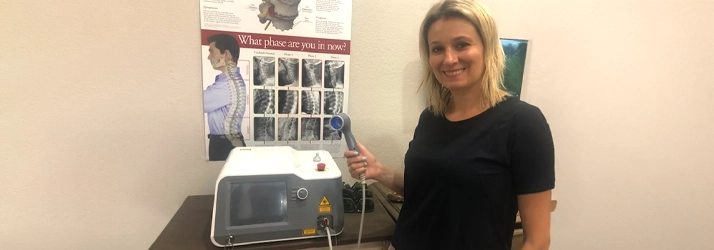Photobiomodulation Therapy in Houston TX

The use of laser is a high tech, non-invasive approach to therapy and healing that is reshaping medicine and the way that patients are being treated while improving human health through photomedicine solutions. Research is quickly progressing in identifying conditions that can be treated effectively and in facilitating new developments in therapy laser technology.
Photobiomodulation Therapy (PBMT) in Houston TX has been officially defined as a form of light therapy that utilizes nonionizing forms of light sources, including lasers, LEDs, and broadband light, in the visible and infrared spectrum.
It is a NONTHERMAL PROCESS involving endogenous chromophores eliciting photophysical (i.e., linear and nonlinear) and photochemical events at various biological scales. This process results in beneficial therapeutic outcomes including but not limited to the alleviation of pain or inflammation, immunomodulation, and promotion of wound healing and tissue regeneration.
Revolutionary New Pain Relief Technique In Houston TX
Unlike injections and prescriptions which just mask the symptoms and do nothing to treat the injury, high-Intensity Laser Therapy delivers light energy units, in the form of photons, to damaged cells. These photons, absorbed by the cells through laser therapy stimulate the mitochondria to accelerate the production of Adenosine Triphosphate (ATP). This biochemical increase in cell energy is used to help transform cells from a state of illness to a stable, healthy state. The result is reduces inflammation, increases blood flow, stimulates tissue growth, and helps aid the body’s own healing process.
Clinical Effects on Tissues and Cells:
INFLAMMATION: Reduced
Photobiomodulation is Anti-Inflammatory and increases the inflammatory mediators such as macrophages, neutrophils, and lymphocytes that accelerate and resolve the inflammatory process. Research has documented effects at reducing inflammation producing cytokines such as Interleukin-1. At the same time, Photobiomodulation has shown to reduce damaging free radical levels by increasing SOD levels (Super Oxidase Dismutase). This helps get painful inflammation under control by targeting the cells and enzymes that make inflammation worse.
PAIN: Reduced Faster with Longer Lasting Relief
Photobiomodulation provides an Anti-Pain or Analgesic benefit. It decreases nerve sensitivity by decreasing bradykinin; a pain eliciting chemical. It normalizes ion channels [cellular gatekeepers] and releases endorphins [the body’s natural pain reliever] and enkephalins [related to endorphins] from the brain and adrenal gland that produce an analgesic effect. Photobiomodulation also has a pain-blocking effect on certain nerve fibers and decreases nerve sensitivity.
VASCULAR SYSTEM: Increased Angiogenesis and Neovascularization
Photobiomodulation provides an anti-edemic effect causing the blood vessels and the lymphatic vessels to widen in a process called vasodilation. The treated area undergoes a process of angiogenesis, or the growth of new small blood vessels. This allows more nutrients to be supplied to the injured area and also aids removal of waste from dead or damaged cells. Improving the drainage through the lymphatic vessels and veins also helps with removing the excessive swelling.
CELLS: Metabolic Growth Increased
Photobiomodulation creates higher outputs of specific enzymes, greater oxygen and food particle loads for blood cells. This results in energizing cells and stimulates the right molecules in the target area while increasing tissue oxygenation, ATP (adenosine-tri-phosphate), synthesis (energy creation) and intercellular exchanges. This process increases the energy available to the cell so that the cell can take on nutrients faster and get rid of waste products. As a result the cells of tendons, ligaments, nerves and muscles are repaired faster.
STEM CELLS: Increased Activation
Photobiomodulation increases the number of stem cells, which enhances the healing process.
IMMUNE SYSTEM: Immunoregulation Stimulated
Photobiomodulation has a direct effect on the immune system by stimulating of immunoglobulins and lymphocytes. Laser energy is absorbed by chromophores (molecule enzymes) that react to the laser light. The enzyme flavanone-nucleotide is activated and starts the production of ATP (adenosine tri-phosphate), which is the major carrier of cell energy and the energy source for all chemical reactions in the cells.
NERVES: Improved Function and Regeneration
Photobiomodulation increases the proliferation of growth factors that promote neuronal sprouting and myelin formation for optimal nerve recovery. Nerves allow your brain to communicate with your body and your body to communicate with your brain. When your body is in pain, particularly if it’s chronic, the nerves stop working as well. Slow recovery of nerve functions in damaged tissue can result in numbness and impaired limbs. Photobiomodulation helps nerve signal transmission improve and speeds up the process of nerve cell reconnection, increasing the amplitude of action potentials to optimize muscle action.
MUSCLES: Tissue Repair and Regeneration
Photobiomodulation penetrates deep into tissue and stimulates cellular reproduction and growth that result in repair of damaged muscle fibers and activation of myogenic satellite cells that lead to regeneration of muscle tissue.
SCAR TISSUE: Collagen Production
Photobiomodulation increases collagen production that allows proper alignment and remodeling of collagen, which reduces the formation of scar tissue following tissue damage from repetitive motion injuries, cuts, scratches, bums or surgery. By getting treatment early, it can prevent the build-up of scar tissue and is beneficial for torn ligaments, tendons or muscles, or post-surgery. With less tissue scarring, there is reduced chronic pain often associated with scars.
JOINTS: Cartilage Production
Photobiomodulation produces an increase in chondrocyte and collagen production. This allows improved cartilage deposition and joint function.
WOUNDS: Healing Accelerated
Photobiomodulation stimulates Fibroblast development in damaged tissue. (Fibroblasts are the building blocks of collagen, which is predominant in wound healing). Collagen is the essential protein required to replace old tissue or to repair tissue injuries. Additionally greater strength of new tissue (better tensile strength), occurs that protects against further breakdown or tissue damage.
BONES: Repair Accelerated
Photobiomodulation creates proliferation of osteocytes and remodeling of bone extracellular matrix resulting in accelerated bone repair.
TRIGGER AND ACUPUNCTURE POINTS: Stimulated
Photobiomodulation is effective in eliminating painful trigger points. It is also another treatment option of stimulating acupuncture points without the discomfort associated with needling.
ACUTE AND CHRONIC PATHOLOGIES: Resolved
Both acute and chronic pathologies respond well to the photochemical mechanism of action provided by Photobiomodulation and are often resolved or made manageable resulting in a significantly improved quality of life.
OFFICE HOURS
Monday
9:00am - 12:00pm
3:00pm - 6:00pm
Tuesday
By Appointment
Wednesday
9:00am - 12:00pm
3:00pm - 6:00pm
Thursday
By Appointment
Friday
9:00am - 12:00pm
3:00pm - 6:00pm
Saturday & Sunday
Closed
Lifetime Wellness Chiropractic
12242 Queenston Blvd Ste G
Houston, TX 77095



